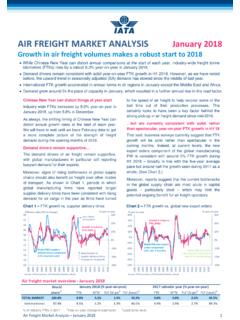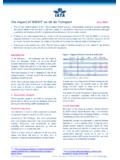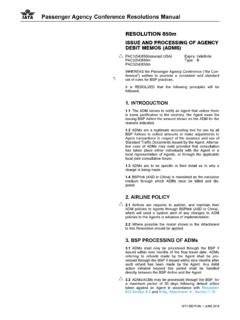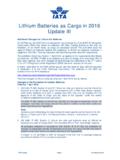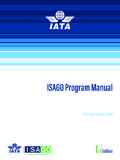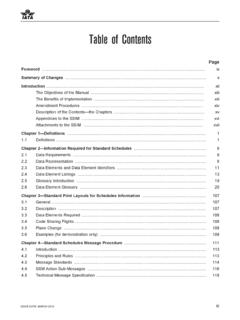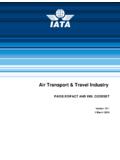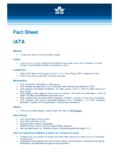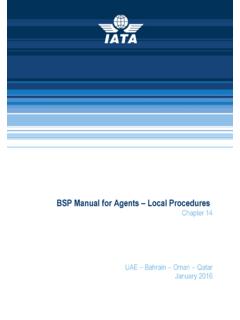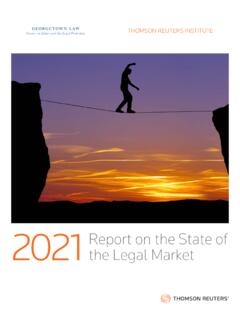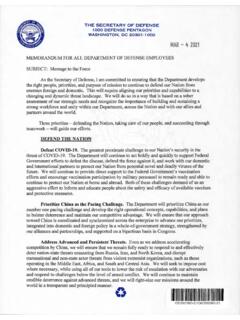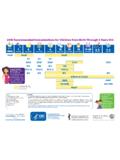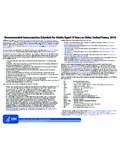Transcription of How to become CEIV Pharma Certified - IATA - Home
1 How to become CEIV Pharma CertifiedQ4 20202 Content : Pharma logistical market , air cargo losing market share to other modes of + Regulations: The nature of the industry requires strong cooperation and IATA as a standard setting : CEIV Pharma is a concerted effort to improve the level of competency, operational and technical and methodology: Validate knowledge, facilities, as well as processes, train stakeholders and recognize Pharma approach, governance, and organization: A partnership model and approach tailored to the needs of the different stakeholders in the value chain with qualified : A win-win opportunity for all Pharma : Update of activities723 Content : Pharma logistical market , air cargo losing market share to other modes of + Regulations: The nature of the industry requires strong cooperation and IATA as a standard setting : CEIV Pharma is a concerted effort to improve the level of competency, operational and technical and methodology: Validate knowledge, facilities, as well as processes, train stakeholders and recognize Pharma approach, governance, and organization: A partnership model and approach tailored to the needs of the different stakeholders in the value chain with qualified : A win-win opportunity for all Pharma : Update of activities4 Background: Pharmaceutical Market DevelopmentThe global biopharma sales trend is projected to go upwards, with cold chain products growing at the rate of non-cold chain products during the 2018 2024 periodGlobal Biopharma Sales Trend 2018 -2024($ Billions)Source.
2 Pharmaceutical Commerce By 2024, world sales of cold-chain drugs and of biologicswill likely top $440 billion, in a global biopharma market exceeding $ trillion. This data does not include the dramatic shifts that have (or will) occur due to the impact of COVID19. Expected impacts from COVID19 include: A noticeable drop on the logistics practices and shipments by air, ground and sea due to limited capacity; and An increase in cold-chain activities with the development of a vaccine . $296$341$388$440$904$959$1,052$1,145$1,2 00$1,300$1,440$1,585$0$200$400$600$800$1 ,000$1,200$1,400$1,600$1,800201820202022 2024 Cold Chain (+48% growth)Non-Cold Chain (+27% growth)Total (+32% growth)5 Background: Pharmaceutical Market DevelopmentThere are currently 250 COVID19 vaccine candidatesFeasibility of In-Country LogisticsSource: DHL / McKinsey / World Bank Vaccines typically take 5 to 20 years for development, however given the current pandemic, speed to market is key and thus are most likely to be transported via air.
3 Assuming global vaccine coverage of 10 billion doses, it is expected vaccine distribution will require ~200,000 movements by pallet on 15,000 flights. Given the current infrastructure, the feasibility to distribute COVID-19 vaccines within destination countries will greatly vary depending on the level of cold storage required (please see graphic on left).Scenario 1: Stringent temperature requirements (as low as -80 C) with high feasibility at scale in ~25 countries with total population of ~ Scenario 2: Conventional temperature requirements (+2 8 C or even higher) with high feasibility at scale in ~60 countries with total population of ~ $ $ $ $ $ $ $ $ $0$10$20$30$40$50$60$70$80$90$1002018202 020222024 Non-Cold ChainCold Chain6 Background: Pharmaceutical Market DevelopmentSpending in biopharma logistics will continue to rise to meet demandGlobal Biopharma Logistics Spending (2016 2022)($ Billions)Source: Pharmaceutical Commerce It is estimated cold-chain logistics spendingin 2020 will be about $ billion worldwide in a $ billion overall Pharma logistics market.
4 There are three increased number of container re-use services (which requires a commercially viable returns network; introduction of more recyclable containers ( can be disposed in municipal waste recycling centers); used of electronics to track shipments in terms of conditions and location in real-time. $ $ $ $ $ $ $ $ Chain TransportCold Chain PackagingNon-Cold Chain TransportNon-Cold Chain Packaging7 Background: Pharmaceutical Market DevelopmentIt is estimated the global industry will spend $15 billion on cold chain logistics in 2018, up from $ billion in 2015 Estimated Breakdown of Logistics Spending (2015 vs 2018)($ Billions)$ $ $ $ $ $ $ $ It is estimated $ billion will be spent in cold chain transportation $ billion will be in specialized tertiary packaging and instrumentation such as: insulated boxes; blankets; phase-change materials; active temperature-control shipping containers; and various temperature sensors and recorders.)
5 There is a trend towards more spending on devices and systems for controlled room temp (CRT)Source: Pharmaceutical Commerce8 Background: Pharmaceutical Market DevelopmentOut of the USD , USD of Cold Chain Transport Spending will be spent on Air FreightEstimated Breakdown of Cold Chain Transport Spending By Mode (2018)($ Billions)$ $ $ $ $ $ $ & ParcelSeaTruck & Multi ModeSource: Pharmaceutical Commerce9 Background: Pharmaceuticals Use Air TransportPharmaceutical transport by air has shown stronger growth than the air cargo market as a wholeSource: Seabury Global Trade Database (May 2017)Long Term Air Trade Growth 2000 -2016 (% CAGR) MaterialsHigh TechMachineryPerishablesFashionChemicals AutomotivePharmaGlobal Air Trade10 Background: Pharmaceuticals Use Air TransportThe United States is the biggest exporter and importer of pharmaceuticals by airSource: Seabury Global Trade Database (November 2017) Pharma Air Trade Destinations JAN-AUG 2017 (Thousand Tonnes) 86543320191412127050100150200250 USAI ndiaGermanyChinaFranceUKBelgiumOther7323 13131298214050100150200250 USAC hinaJapanGermanyBrazilNetherlandsIndiaOt herExportImport11 Background: Pharmaceuticals Use Air TransportPharmaceutical represent an important and lucrative sector for air cargo, contributing approximately US$ billion to total airline cargo revenuePharmaceutical Trade By Air 2017 Per Volume, Airline Cargo Revenue and Value (%) Cargo RevenueValueSource: Seabury Global Trade Database (November 2017)12 Background.
6 Pharmaceuticals Use Air TransportPharmaceuticals shipped under CRT, COL or ACT command an average premium of 25-60% above the rate charged for the average air cargo shipment on the same country pair Source: IATA EconomicsPharma Rates by Handling Code 2017 Avg. Air Cargo Rate = 1 Avg. PILAvg. CRTAvg. COLAvg. Air CargoCRT = Controlled Room TemperatureCOL = Cool GoodsACT = Active Temperature Controlled13 Background: Pharmaceuticals Use Air TransportAs a result, Pharma air trade growth is based on high value Pharma products (> $150/kg) compared to Pharma ocean trade growth which relies on low value products (< $15/kg)Source: Seabury Global Trade DatabasePharma Trade By Product Value: Air vs Ocean 2000 2016 (Thousand Tonnes) 0100200300400500600010002000300040005000 6000 AIROCEAN265-823821885502,7311,7925862557 35,43714 Content : Pharma logistical market , air cargo losing market share to other modes of + Regulations: The nature of the industry requires strong cooperation and IATA as a standard setting : CEIV Pharma is a concerted effort to improve the level of competency, operational and technical and methodology.
7 Validate knowledge, facilities, as well as processes, train stakeholders and recognize Pharma approach, governance, and organization: A partnership model and approach tailored to the needs of the different stakeholders in the value chain with qualified : A win-win opportunity for all Pharma : Update of activities15 Background: Air freight has lost market share to ocean freightOver the past 16 years, ocean Pharma trade has added significant volumes particularly in the mid-value Pharma categorySource: Seabury Global Trade DatabasePharma Share: Air vs Ocean9%70%91%30%WeightValueGlobal Trade of Pharma , 2016 Air Weight Share, 2000 2017 (MAR)OCEANAIRAir Share Losing Out to Ocean16 Background: Critical Issues Raised by the ShippersIndustry partners in the cold chain need to ensure quality services Due to a lack of compliance, standardization, accountability and transparency across the air transport supply chain a majority ofall temperature excursions occur while the package is in the hands of airlines/airports.
8 Temperature deviation denature the product, render it worthless and be harmful to the health of the patient. Products can be lost, scrapped, returned leading to significant reaching their destination degraded because of incorrect shippingAvoidThat scrapped pharmaceuticals can be attributed to logistics issues aloneStopDamaging temperature-sensitive products during transport due to a broken cold chain17 Background: Critical Issues Raised by the ShippersLooses associated with temperature excursions in healthcare are around a staggering ~USD 35 BSource: World Health Organization, Parenteral Drug Association, , , other industrial Logistic CostsReplacement CostsClinical Trial CostsRoot Cause AnalysisLost Product Labor CostsDirect Labor CostsTrial Production Costs The average costs of root cause analysis for each excursion can range from $3K to up to $10K (avg.)
9 USD per year)Losses associated with temperature excursionsIn USD BillionTotal: USD Cargo Industry Concerns and ChallengesTemperature Excursions Where do they occur?Source: ExpeditorsDestinationTransferOriginAirli neCargo HandlerRegulatoryAuthorityTruckerFreight ForwarderTruckerConsigneeAirlineAirlineC argo HandlerAirlineAirlineTruckerFreightForwa rderAirlineCargo HandlerAirlineManufacturerLow RiskMedium RiskHigh Risk19 Air Cargo Supply Chain ChallengesThe process is quite complex and shippers have difficulties to identify stakeholders that meet standards and regulations14 milestones from start to end. HOW CAN YOU MANAGE THIS ?Pick-upGround handler BRUF orwarder X BRUS hipperInOutInOutAirline BRU SIN -SYDF orwarder YSYDC onsigneeInInOutSYD inGround handler SYDSIN in outBRU outInOutExample of Flow from BRU to SYD20 Air Cargo Supply Chain ChallengesTemperature control share of pharmaTemperature management market, 2013-2017In percentage of total business A big share of pharmaceutical shipments in the 15-25 C segment are shipped as general cargo.
10 A significant part of pharmaceutical shipments requires temperature controlled transport. 75% of shipments require passive cooling solutions, and 20% require active temperature control. Active temperature control solutions demand a yield premium due to complex requirements. Passive solutions drive volume and are less costly to : Seabury, BRU CargoGeneralCargoPharmaceuticalsTempCont rolActivePassiveABCDE20%80%45%55%25%75%1 0%90%30%70%10%90%21 Air Cargo Supply Chain ChallengesFrom origin to destination pharmaceutical products can be exposed to different climates+35 C-10 CManufacturer &ShippersSolutionsProvidersOrigin Forwarders& Trucking Co sPACKAGINGLOADINGHANDLINGROADTRANSPORTA irportGround HandlersAirportGround HandlersIN-FLIGHTCONDITIONSHANDLINGAIRSI DETRANSPORTHANDLINGUNLOADINGROADTRANSPOR TD estination Forwarders & Trucking Co sDistributors& Consignees22 Air Cargo Industry Concerns and ChallengesHeavily regulated industry with no global standards and certification for handling of pharmaceutical products Regulations for transporting pharmaceutical products vary around the world Increasing number of regulations around the world to implement and comply with Increasing number of
